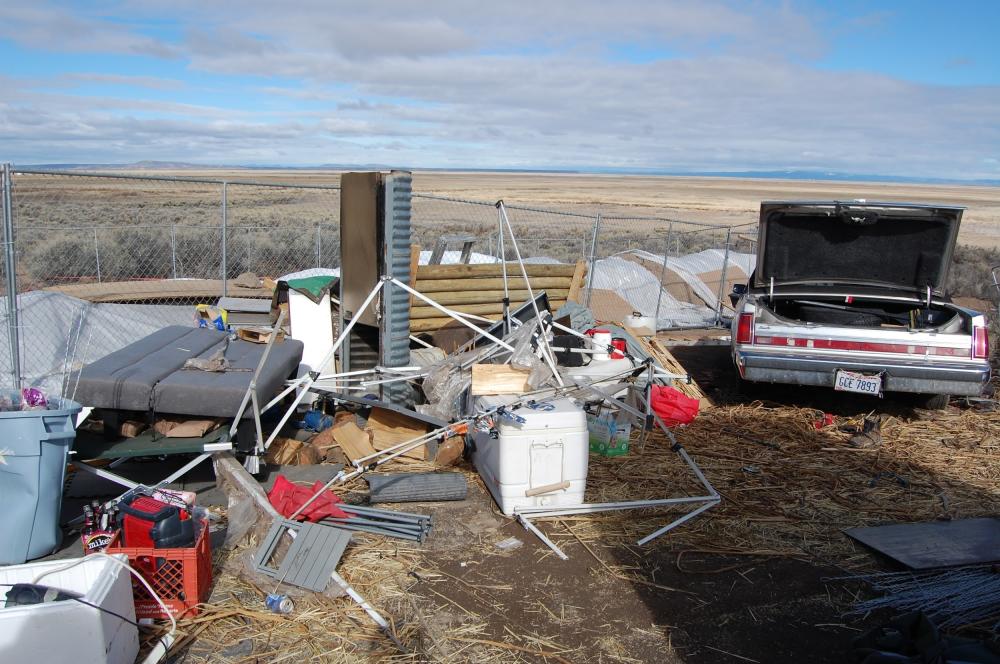In January and February, armed anti-federalists took over a wildlife refuge in Oregon for 41 days.
They said they were protesting in support of two Oregon ranchers sentenced to prison for arson. During the occupation of the Malheur National Wildlife Refuge, one man was killed by police; since the militants surrendered, 25 people have been charged with crimes related to the occupation, Oregon Public Media reports.
After the occupation ended on Feb. 11, FBI investigators examined the scene before handing it back to the U.S. Fish and Wildlife Service on Feb. 23.
The Fish and Wildlife Service has now released photos of the scene that awaited them when they returned to the federal property. You can view the full album here.
The images show personal property and trash strewn across the refuge building, liquor bottles tucked into a disarranged sofa and a large dent in a refuge wall.
The unkempt appearance of the property was presaged by a conversation two of the occupiers had with a supporter on the final day of the occupation.
Gavin Seim — an activist who live-streamed his conversations with the militants during the final days of the occupation — at one point prompted them to describe how well they had cared for the property. The answer, from husband and wife Sean and Sandy Anderson, wasn’t quite what he was expecting:
Gavin Seim: “Just to be clear, since we’ve got you on here, ’cause you know, we know that they’re going to try to spin this their way — That refuge is in better shape and cleaner and better maintained than before the patriots showed up there, isn’t it?”
Sean Anderson: “Um. There’s a little bit of mess because people just left in such a hurry, because they were afraid. But we actually spent some time down there and tried to clean that up and do what we could to, you know, wipe things down and mop and sweep.”
Sandy Anderson: “It was left in major disarray when everybody panicked and left.”
Seim: “Right, but overall, there was a lot of work and care given to the place.”
Sandy Anderson: “Exactly. But — but — but that’s changed now, because no one was here to maintain it and no one got the chance to clean up when they left. They just, they grabbed what they needed and got out and left everything sitting the way it was, and we had to move our camp up here, because we did not want to be in the building.”
Seim: “So it’s important then to note that any mess that the government comes in and portrays is because of their terrorizing of the people and scaring them out of there and trying to intimidate them.”
You can hear that conversation here. (Note: Elsewhere this video contains expletives).
One occupier has also been accused of stealing cameras and other equipment from the refuge, the Blue Mountain Eagle reports, and the Paiute tribe has denounced the occupiers for desecrating sacred land. (The Andersons told Seim that the occupiers did not damage any artifacts.)
This week, reporters were allowed back onto the refuge for the first time since the end of the occupation.
John Sepulvado of NPR member station Oregon Public Broadcasting was there. He reported for OPB: “The refuge, which was blanketed in snow during the 41-day occupation, shows signs of spring’s arrival: birds twitter and chirp and cattle graze in the distance. On the surface, life seems to be moving on. However, there are numerous costs in returning the refuge back to normal.”
The cost of the occupation as a whole, Sepulvado says, includes a price tag of $5.7 million and counting, an enormous backlog of unfinished work on environmental projects, and psychological toll on workers and the community.
“Despite everything, there seems to be considerable progress being made at restoring the refuge to its pre-occupation condition,” Sepulvado reported. “A spokesperson for the Fish and Wildlife Service expects it to be fully open within the next four weeks.”
OPB covered the full story of the occupation in an hourlong audio documentary, 41 Days.
9(MDA3MTA1NDEyMDEyOTkyNTU3NzQ2ZGYwZg004))
